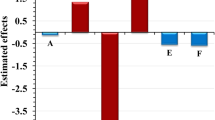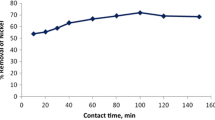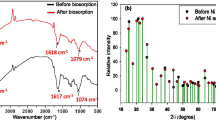Abstract
This work focused on the bioremoval of heavy metals by mangrove-derived Trichoderma biomass in the artificial sewage water. Of the 12 isolates tested, Hypocrea lixii TSK8 (JQ809340) was found to be a potent strain in removal of lead and iron. The bioremoval was enhanced through adsorption kinetics and process optimization using statistical model of the response surface methodology. The magnitude of Langmuir constant was 0.64 L mg−1 and 0.42 L mg−1 for lead and iron, respectively. Adsorption capacity was determined as 49.2 mg g−1 and 51.3 mg g−1 for lead and iron, respectively. The optimized conditions for maximum removal of lead and iron were standardized. The biosorption of metals was also confirmed by scanning electron microscopic and X-ray energy-dispersive spectrometer analyses. The results revealed that dried biomass of the H. lixii TSK8 was a potent biosorbent for efficient bioremoval of lead and iron.



Similar content being viewed by others
References
Adams P, De-Leij FA, Lynch JM (2007) Trichoderma harzianum Rifai 1295-22 mediates growth promotion of Crack willow Salix fragilis saplings in both clean and metal-contaminated soil. Microb Ecol 54:306–313
Akhtara Kalsoom, Waheed Akhtarb M, Khalidc AM (2007) Removal and recovery of uranium from aqueous solutions by Trichoderma harzianum. Water Res 41:1366–1378
Allen LH (2002) Supplement: Forging effective strategies to combat iron deficiency. J Nutr Am Soc Nutr Sci 132:813S–819S
Amini M, Younesi H, Bahramifar N, Lorestani AAZ, Ghorbani F, Daneshi A, Sharifzadeh M (2008) Application of response surface methodology for optimization of lead biosorption in an aqueous solution by Aspergillus niger. J Hazard Mater 154:694–702
Annibale D, Sermanni GG, Federic F, Petruccioli M (2006) Olive-mill waster waters: a promising substrate of microbial lipase production. Bioresour Technol 15:1828–1833
Arbanah M, Miradatul Najwa MR, Ku Halim KH (2012) Biosorption of Cr(III), Fe(II), Cu(II), Zn(II) Ions from Liquid Laboratory Chemical Waste by Pleurotus ostreatus. Int J Biotechnol Wellness Ind 1:152–162
Ayyappan R, Sophia AC, Swaminathan K, Sandhya S (2003) Removal of Pb(II) from aqueous solution using carbon derived from agricultural wastes. Process Biochem 40:1293–1299
Brasil JL, Ev RR, Milcharek CD, Martins LC, Pavan FA, Santos Dias SLP, Dupont J, Norena CPZ, Lima EC (2006) Statistical design of experiments as a tool for optimizing the batch conditions to Cr(VI) biosorption on Araucaria angustifolia wastes. J Hazard Mater 133:143–153
Canizares-Villanueva RO, Travieso L (1991) Inmovilización de microalgaspara el tratamiento de residuales. Informe CONACyT. Proyecto 8.07/91Programa Cuba-Mexico
Cavaco SA, Fernandes S, Quina MM, Ferreira LM (2007) Removal of chromium from electroplating industry effluents by ion exchange resins. J Hazard Mater 144:634–638
Dae WC, Young HK (2005) Chromium (VI) removal in a semi continues process of hallow fiber membrane with organic extractants. Kor J Chem Eng 22:894–898
Dean JG, Bosqui FL, Lanouette KH (1972) Removing heavy metals from wastewater. Environ Sci Technol 6:518–524
Deng H, Honghong Y, Xiaolong T, Ping N, Qiongfen Y (2011) Adsorption of CO2 and N2 on Coal-based activated carbon. Adv Mater Res 204–210:1250–1253
El-Kassas HY, El-Taher EM (2009) Optimization of batch process parameters by response surface methodology for mycoremediation of chrome-VI by a chromium resistant strain of marine Trichoderma Viride. Am-Eurasian J Agric Environ Sci 5(5):676–681
Gadd GM (1992) Heavy metals pollutants: environmental and biotechnological aspects. Encycl Microbiol 2:22–43
Gasser B, Sauer M, Maurer M, Stadlmayr G, Mattanovich D (2007) Transcriptomics-based identification of novel factors enhancing heterologous protein secretion in yeasts. Appl Environ Microbiol 73:6499–6507
Gazem MAH, Nazareth S (2013) Sorption of lead and copper from an aqueous phase system by marine-derived Aspergillus species. Ann Microbiol 63:503–551
Goksungur Y, Uren S, Guvenc U (2005) Biosorption of cadmium and lead ions by ethanol treated waste baker’s yeast biomass. Bioresour Technol 96(1):103–109
Gomathi V, Saravanakumar K, Kathiresan K (2012) Biosorption of chromium by mangrove-derived Aplanochytrium sp. Afr J Biotechnol 11(95):16177–16186
Joshi PK, Anand S, Sonu M, Raman K, Namita S (2011) Bioremediation of heavy metals in liquid media through fungi isolated from contaminated sources. Indian J Microbiol 51(4):482–487
Kehe F, Lixing L, Lili F, Tong L, Jie C (2010) Accumulation of copper in Trichoderma reesei transformants, constructed with the modified Agrobacterium tumefaciens-mediated transformation technique. Biotechnol Lett 32:1815–1820
Kurt K, Apaydin O, Gonullu MT (2007) Reduction of COD in wastewater from an organized tannery industrial region by Electro-Fenton process. J Hazard Mater 143:33–40
Lebeau T, Braud A, Jezequel K (2008) Performance of bioaugmentation-assisted phytoextraction applied to metal contaminated soils: a review. Environ Pollut 153:497–522
Lenilson CR, Hercules VF, Rodrigo FL, Lara DS, Andre LMP (2012) Stereoselective bioreduction of 1-(4-Methoxyphenyl) ethanone by whole cells of marine-derived fungi. Mar Biotechnol 14:358–362
Lo W, Chua H, Lam KH, Bi SP (1999) A comparative investigation on the biosorption of lead by filamentous fungal biomass. Chemosphere 39(15):2723–2736
Marcia RS, Luiz FL, Rômulo AA, Cláudio A, Nascimento BC (2013) Biosynthesis and uptake of copper nanoparticles by dead biomass of Hypocrea lixii isolated from the metal mine in the Brazilian Amazon region. Plos One 8(11):80519
Mavrov V, Stamenov S, Todorova E, Chmiel H, Erwe T (2006) Removal of nickel ions from wastewater by Mg(OH)2/MgO nanostructures embedded in Al2O3 membranes. J Alloys Compd. 426:281–285
Mohan VS, Karthikeyan J (1997) Removal of lignin and tannin aqueous solution by adsorption onto activated charcoal. Environ Poll 1–2:183–197
Montgomery DC (2001) Design and analysis of experiments, 5th edn. Wiley, New York
Ortega NO, Nitschke M, Mouad AM, Landgraf MD, Rezende MOO, Seleghim MHR, Sette LD, Porto ALM (2011) Isolation of Brazilian marine fungi capable of growing on DDD Pesticide. Biodegradation 22:43–50
Schiewer S, Volesky B (1995) Modelling of the proton–metal ion exchange in biosorption. Environ Sci Technol 29:3049–3058
Sharma S, Adholeya A (2011) Detoxification and accumulation of chromium from tannery effluent and spent chrome effluent by Paecilomyces lilacinus fungi. Int Biodeterior Biodegrad. 65:309–317
Silbergeld EK, Waalkes M, Rice JM (2000) Lead as a carcinogen: experimental evidence and mechanism of action. Am J Ind Med 38:316–325
Smedley PL, Zhan M, Zhang G, Luo Z (2003) Mobilisation of arsenic and other trace elements in fluviolacustrine aquifers of the Huhhot Basin, Inner Mongolia. Appl Geochem 18(9):1453–1477
Srivastava AK, Naqvi AH, Sinha AK, Vishwakarma SR, Roy GC (2004) Genotype and environment interaction in Antheraea mylitta Drury and its implications. Pers Cytol Genet 11:219–224
Tang LC, Xu K (2002) A unified approach for dual response surface optimization. J Qual Technol 34:437–447
Tastan BE, Ertugrul S, Donmez G (2010) Effective bioremoval of reactive dye and heavy metals by Aspergillus versicolor. Bioresour Technol 101:870–876
Ting ASY, Choong CC (2009) Bioaccumulation and biosorption efficacy of Trichoderma isolate SP2F1 in removing copper (Cu(II)) from aqueous solutions. World J Microbiol Biotechnol 25:1431–1437
Travieso L, Pellon A, Benitez F, Sanchez E, Borja R, O’Farrill N, Weiland P (2002) BIOALGA reactor: preliminary studies for heavy metals removal. Biochem Eng J 12:87–91
Tsekova K, Todorova D, Ganeva S (2010) Removal of heavy metals from industrial wastewater by free and immobilized cells of Aspergillus niger. Int Biodeterior Biodegradation 64:447–451
Wang S, Boyjoo Y, Choueib A (2005) A comparative study of dye removal using fly ash treated by different methods. Chemosphere 60:1401–1407
Wang Y, Sakamoto Y, Kamiya Y (2009) Remediation of actual groundwater polluted with nitrate by the catalytic reduction over copper-palladium supported on active carbon. Applied Catalysis A. 361:123–129
Xiao X, Luo SL, Zeng GM, Wan WZY, Chen L (2010) Biosorption of cadmium by endophytic fungus (EF) Microsphaeropsis sp LSE10 isolated from cadmium hyper accumulator Solanum nigrum L. Bioresour Technol 101:1668–1674
Yan G, Veraraghavan T (2001) Heavy metal removal in a biosorption column by immobilsed Mucar rouxii biomass. Bioresour Technol 78:243–249
Yetilmezsoy K, Demirel S, Vanderbei RJ (2009) Response surface modeling of Pb(II) removal from aqueous solution by Pistacia vera L.: Box–Behnken experimental design. J Hazard Mater 171:551–562
Zhang GS, Qu JH, Liu HJ, Liu RP, Wu RC (2007) Preparation and evaluation of a novel Fe-Mn binary oxide adsorbent for elective arsenite removal. Water Res 41:1921–1928
Acknowledgments
The authors are thankful to the authorities of Annamalai University, India.
Author information
Authors and Affiliations
Corresponding author
Electronic supplementary material
Below is the link to the electronic supplementary material.
Rights and permissions
About this article
Cite this article
Saravanakumar, K., Kathiresan, K. Bioremoval of lead and iron from sewage water by mangrove-derived Hypocrea lixii . Int. J. Environ. Sci. Technol. 12, 3341–3350 (2015). https://doi.org/10.1007/s13762-014-0703-z
Received:
Revised:
Accepted:
Published:
Issue Date:
DOI: https://doi.org/10.1007/s13762-014-0703-z




